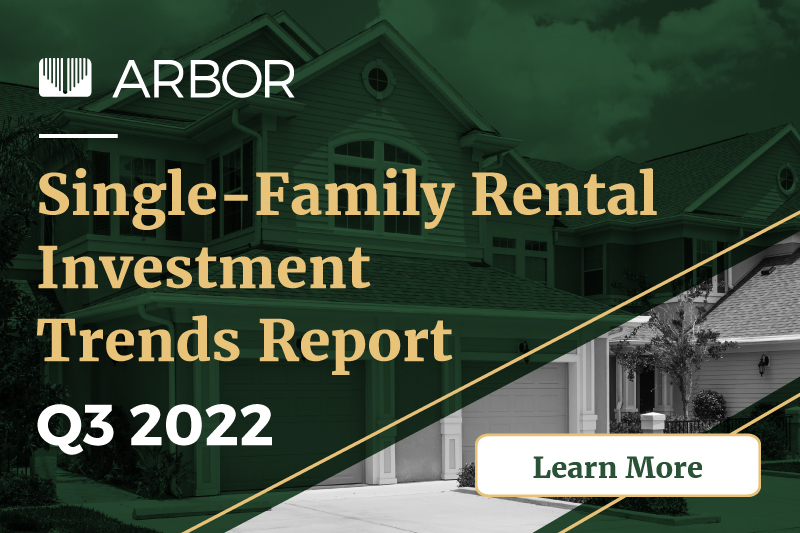Arbor’s Single-Family Rental Investment Trends Report Q4 2023, developed in partnership with Chandan Economics, explores a multifamily sector ending the year on a high note as demand climbs for quality single-family rental (SFR) homes. Even with interest rates high, more shovels went in the ground for SFR projects, increasing build-to-rent (BTR) construction’s market share to a new peak. In the third quarter, SFR’s robust rent collections and retreating cap rates also demonstrated the sector’s continued resiliency amid economic dislocation.
Top Markets for Renters Under 30

Renters 30 years of age and under, who now make up slightly more than one-quarter of the heads of households of rental units, are bolstering housing demand in markets known for their affordability and livability.

Five Benefits of Making Multifamily Investing Part of Your Portfolio

Multifamily investing involves the purchasing of properties with rentable housing units. In these types of investments, a group of investors often works together to mitigate costs, split profit shares, and reduce risk. Multifamily properties include apartment complexes, condo buildings, and townhouses, among other property types. When investing in multifamily properties is researched and undertaken prudently, it can generate steady and reliable income streams in all economic cycles.

Who is Making Single-Family Rentals the New Starter Homes of Choice?

Driven by cyclical, demographic, and technological factors, the single-family rental (SFR) sector has matured over the past decade. The once-fragmented industry has both coalesced and professionalized. While the evolution of the SFR sector has been explored at length, a clear picture of its core set of tenants is just now coming into focus.

FHFA Loan Caps for 2023: What Multifamily Borrowers Need to Know

The Federal Housing Finance Agency (FHFA) announced a $6 billion rollback of Fannie Mae and Freddie Mac’s volume cap for loan purchases for 2023 to $150 billion ($75 billion for each agency) as multifamily transaction activity has declined in 2022. FHFA also added new provisions to its mission-driven lending initiative designed to increase investment in affordable and workforce housing, two sectors with significant growth potential in a tight housing market.

Arbor CEO Ivan Kaufman Leads Thought-Provoking Fireside Chat at eCore22

Arbor Chairman and CEO Ivan Kaufman kicked off the first full day of eCore22 in Miami this November with an informative and intimate panel discussion, featuring Charles Ostroff, SVP Multifamily Chief Credit Officer at Fannie Mae, Robert Verrone, Principal at Iron Hound Management Company, and Aaron Kurlansky, Principal at Sheridan Capital, that covered the most pressing economic issues of the moment.

The LIBOR/SOFR Transition: What Multifamily Borrowers Need to Know

The highly anticipated transition from LIBOR® to SOFR, which goes into effect after June 30, 2023, will make SOFR the standard benchmark rate across a wide range of financial products. Although the financial community is expecting a smooth transition, there are notable differences between the two rates that will influence multifamily lending.

How Arbor Stays Ahead of an Evolving Multifamily Sector

In the last quarter of 2022, the multifamily sector continues to thrive despite ongoing economic uncertainty. As the investment community looks ahead to 2023, Arbor’s Managing Director, Senior Production Officer Jean-Laurent Pouliot discusses what’s in store for multifamily and how Arbor is positioned to help investors continue to exceed expectations next year.

Why is Rent Inflation Still High While Reports Show Prices Cooling?

With the latest release of the Consumer Price Index (CPI) report from the U.S. Bureau of Labor Statistics (BLS), policymakers and consumers alike found signs of inflation relief for the first time in a long time. Despite the CPI’s overall improvement in October, one notable price category is still seeing rising inflation: rent of primary residence. The annual growth rate for the rent component of the CPI has now increased for 15 consecutive months.

Single-Family Rental Investment Trends Report Q3 2022

The single-family rental (SFR) market maintained a favorable outlook in the third quarter of 2022 as the national housing market began cooling. Amid economic headwinds, SFR is well-positioned as a primary alternative for would-be homebuyers priced out of ownership in today’s high-interest-rate housing market.

Small Multifamily Investment Trends Report Q3 2022

With investors now seeking inflation protection, the small multifamily sector continues to see gains. Arbor’s new quarterly Small Multifamily Investment Trends Report, published in partnership with Chandan Economics, sheds light on key trends, including firm cap rates, climbing valuations, and elevated originations, despite tightening underwriting standards.


